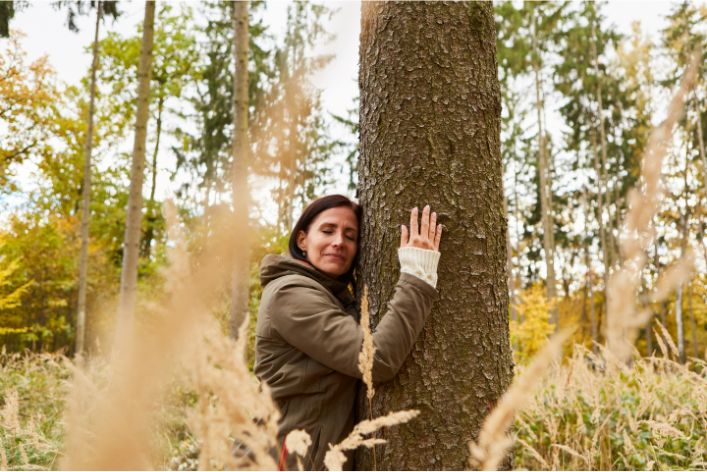Last Updated on May 16, 2023
Forests can offer more than just a picturesque view. As we become increasingly busy and connected with technology, we crave an escape into nature. Forest bathing, or shinrin-yoku, which originated in Japan in the 1980s, is not about physical exercise but rather about connecting with nature in a mindful way. It involves spending time in a forest, taking in the atmosphere through our senses, and immersing ourselves in the beauty of nature.

Studies have shown that forest bathing has several potential benefits, including reduced stress levels, improved mood, lowered blood pressure, and increased immune function. Trees release phytoncides, chemicals that protect them from insects and decay, and also have antimicrobial properties that can benefit humans. Inhaling these chemicals while spending time in nature has been linked to an increase in natural killer cells, which can help fight cancer.
Aside from the scientific backing, forest bathing can also offer a sense of calm and peace in our busy lives. It can help us slow down and become more present in the moment. The forest can become a sanctuary for us to retreat to when we need to escape the noise of the modern world and recharge our batteries.
So next time you’re feeling overwhelmed, consider taking a trip to the forest for some much-needed therapy. It doesn’t require any special training or equipment, just an open mind and a willingness to connect with nature.
Read: The Wonders of Walking: How a Simple Stroll Can Improve Your Health
History of Forest Bathing in Japan
The practice of forest bathing, known as shinrin-yoku in Japan, has been used as a form of therapy since the 1980s. It originated from traditional Japanese healing techniques that aimed to promote relaxation and well-being. While it is now a globally recognized practice, it remains a significant part of Japanese culture.
The origins of forest bathing can be traced back to the 1980s when the Japanese government initiated a set of studies to investigate the effects of spending time in nature. The studies revealed that spending time in forest environments led to a decrease in stress hormones, improved immune function, a decrease in anxiety, and an increase in overall mood.
Shinrin-yoku involves deep breathing exercises, focusing on the senses and surroundings, and exploring natural environments. Overall, forest bathing is a peaceful mindfulness practice that can help individuals connect with nature and promote relaxation.
Cultural Significance
In Japanese culture, nature holds significant importance, and forest bathing emphasizes this. It is seen as a form of spiritual practice that helps individuals connect with their surroundings and embrace the beauty of nature. Japanese people hold nature in high regard and believe that nature helps connect individuals with their true selves and promotes healing.
While forest bathing may seem like a new trend, it has been a common practice in Japan for centuries. Japanese people have been known to indulge in nature and find solace in its beauty. Forest bathing is a way of promoting mindfulness, a form of meditation that reduces stress, and promotes overall well-being.
In addition to its spiritual significance, forest bathing is also considered a form of preventative medicine in Japan. The practice is believed to help prevent lifestyle diseases such as hypertension, diabetes and promote overall physical health. Spending time in nature is also a way to promote more physical activity and can benefit one’s overall well-being.
Forest bathing has a rich history in Japan and is viewed as an essential part of Japanese culture. It promotes mindfulness and relaxation by connecting individuals with nature, and the practice has been used as a form of therapy for decades. Japanese people hold nature in high regard, and the practice of forest bathing reflects this. While it may seem like a new trend in other parts of the world, forest bathing remains an important part of traditional Japanese healing practices, and its significance extends beyond the realm of a simple wellness activity.
Read: How to Adapt to Climate Change for Better Health
Research on Forest Bathing
According to research on forest bathing, spending time in nature has numerous health benefits. Here’s an overview of some studies that have been conducted:
- A study conducted in Japan showed that forest bathing can lower cortisol levels, the hormone responsible for stress. Participants who spent time in the forest had significantly lower cortisol levels compared to those who stayed in the urban area.
- Another study found that spending time in nature can improve cardiovascular health. Participants who spent time in the forest had lower blood pressure and heart rates compared to those who didn’t.
- Researchers also found that forest bathing can improve mental health. A study conducted in Korea showed that spending time in the forest can reduce symptoms of depression and anxiety.
- Additionally, forest bathing can boost our immune system. Trees release phytoncides, which are compounds that can enhance our immune function. In a study conducted in Japan, participants who spent time in the forest had higher levels of natural killer cells, a type of immune cell that fights cancer.
- Lastly, a study conducted in Finland found that spending time in nature can improve creativity. Participants who spent time in nature had better performance on a creativity test compared to those who didn’t.
Forest bathing has numerous health benefits, including reducing stress, improving cardiovascular health, boosting mental health, enhancing our immune system, and improving creativity. So the next time you feel overwhelmed or stressed, consider taking a walk in the forest.
Read: Why is Good Posture Crucial for Better Health?
Benefits of Forest Bathing
As our lives have become more hectic, we are increasingly disconnected from nature. Forest bathing is a practice that involves being calm and mindful in nature. It was developed in Japan in the 1980s and has since been adopted by other countries.
The practice of forest bathing has numerous health benefits. Here are some of the benefits you can experience from spending time in nature:
Reduction in Stress Levels
Our daily routines can be incredibly stressful. The hustle and bustle of our world can lead to anxiety and depression. However, spending time in a natural environment can help reduce these stress levels.
Studies have shown that forest bathing can lower our cortisol levels. Cortisol is our stress hormone, and too much of it can be harmful to our health. By spending time in nature, we reduce our stress levels and ultimately improve our overall well-being.
Improvement in Mood and Cognitive Function
Have you ever had a bad day and decided to go for a walk in the park? Being in nature can help us feel better. Studies show that spending time in nature can improve our mood and reduce negative emotions like anger, fatigue, and confusion.
Additionally, forest bathing can improve our cognitive function. A study conducted in Japan found that after spending time in nature, participants showed an increase in memory and attention span.
Boost to the Immune System
Spending time in nature can also give a boost to our immune system. Trees give off airborne chemicals called phytoncides. These chemicals have been shown to boost our immune system by increasing the activity of natural killer cells.
The more time we spend in nature, the more phytoncides we are exposed to. A study conducted in the United States found that participants who spent time in nature for two nights had a 50% boost in natural killer cell activity.
Forest bathing is a practice that has been around for decades, and it has numerous benefits. It can help reduce stress levels, improve mood and cognitive function, and boost our immune system. With these benefits in mind, we should all take some time to disconnect from our busy lives and spend more time in nature.
Read: How Do Social Connections Impact Our Health?
Forest Bathing: A Guide to Practice and Enjoy Nature
Do you feel exhausted and stressed? Perhaps, it’s time to take a break and practice Forest Bathing. This new trend encourages people to connect with nature and enjoy its beauty. Let’s explain the key elements of forest bathing and some tips on how to get started.
What is Forest Bathing?
Forest Bathing, also known as Shinrin-yoku, is a practice that originated in Japan. It consists of walking slowly and mindfully in a forest, park, or natural area, and using your senses to immerse yourself in the environment. The aim is to decrease stress and improve overall health and well-being.
Key Elements of Forest Bathing
- Slow down – the first key element of forest bathing is to slow down and disconnect from technology. Turn off your phone and enjoy the present moment! Walk slowly and mindfully, and let your senses guide you.
- Use your senses – use your senses to connect with nature. Look at the colors, shapes, and patterns around you. Listen to the sounds of nature, like birds singing or leaves rustling. Smell the scents of the forest, like fresh earth or pine needles. Touch the textures, like rough bark or soft moss.
- Be present – Try to be present and stay in the moment. Focus on your breath and feel the sensations in your body. Pay attention to your surroundings and let yourself feel curious about them.
- Observe nature – Take the time to observe the nature that surrounds you. Look at the details of the trees, animals, and plants. Learn about the ecosystem and how all living beings coexist in nature.
- Practice gratitude – Finally, practice gratitude for nature and everything it provides. Appreciate the simple things, like a ray of sunlight or a bird’s song.
Tips for People who are New to the Practice
- Find a quiet place – Look for a peaceful natural area where you can practice forest bathing. Avoid crowded places or areas with loud or distracting noises.
- Wear comfortable clothes – Forest bathing involves walking, so it’s important to wear comfortable clothes and shoes. Opt for clothes that will allow you to move freely and feel comfortable in nature.
- Plan ahead – Plan your trip ahead of time. Check the weather and choose a time when you can fully enjoy the experience.
- Bring water and snacks – Bring a bottle of water and some snacks to keep you hydrated and energized.
- Be respectful – Respect nature and its inhabitants. Don’t disturb the animals or plants, and avoid leaving trash or disturbing the environment.
Forest bathing is a great way to improve mental and physical health, reduce stress and anxiety, and enjoy nature’s beauty. Remember to slow down, use your senses, be present, observe nature, and practice gratitude. Whether you’re a nature enthusiast or new to the practice, try to find time for a forest bath and experience the benefits for yourself.
Read: How Do Green Spaces Impact Our Well-being?

Incorporating Forest Bathing Into Your Routine
Forest bathing, also known as Shinrin-yoku, is a practice that originated in Japan in the 1980s. It involves spending time in nature to connect with the environment and improve one’s physical and mental health. Here are some ways to incorporate forest bathing into your routine.
1. Make Time For It
Forest bathing doesn’t have to be a long activity. Even short walks in nature can be beneficial. Consider waking up earlier or taking a break during work to spend some time outdoors. Scheduling it in your calendar can also make it a priority.
2. Unplug
To fully immerse yourself in nature, it’s important to disconnect from technology and social media. Leave your phone at home or put it on airplane mode. This will allow you to be present and take in the natural surroundings without distractions.
3. Engage Your Senses
Use all your senses to fully experience nature. Notice the sounds of the leaves rustling, the birds chirping, and the water running. Take in the smells of the flowers and the fresh air. Touch the bark of a tree or the softness of a flower petal. Take time to taste the fresh fruits or wild berries.
4. Practice Mindfulness
Clear your mind and focus on the present moment. Pay attention to your breathing and the sensations in your body. Be aware of your thoughts, but don’t judge them. Practice mindfulness to fully immerse yourself in the natural environment.
5. Try Guided Forest Bathing
Guided forest bathing sessions are becoming more popular. These sessions are led by trained experts who guide participants through the forest, encouraging them to engage their senses and be present in the moment. Consider attending a guided forest bathing session if you’re new to the practice or want to deepen your connection to nature.
6. No Access to Forests? No Worries
If you live in a city or don’t have easy access to forests, there are still ways to practice forest bathing. Consider spending time in parks, botanical gardens, or other green spaces. Even a walk around the block can be beneficial. Bring nature into your home by adding plants or opening windows to let in fresh air and natural light.
incorporating forest bathing into your routine can have numerous benefits for your physical and mental health. By making it a priority, disconnecting from technology, engaging your senses, practicing mindfulness, and finding alternative green spaces, you can start enjoying the benefits of this rejuvenating practice.
Read: How Can We Improve Air Quality for Better Health?
Misconceptions about Forest Bathing
Forest bathing, also known as Shinrin-yoku, as explained earlier is a practice that originated in Japan. It involves immersing oneself in a forest environment to improve physical, mental, and emotional health. Despite its increasing popularity, there are still many misconceptions about this practice.
Clearing Up Potential Misunderstandings
- Forest bathing is not the same as hiking or exercising in nature. It is a mindfulness practice that aims to connect the individual to the forest, not to get physically fit.
- Forest bathing does not involve using any equipment or tools. Rather, it involves being present in nature with all five senses, without any distractions.
- Forest bathing does not necessarily require a forest. It can be done in any natural environment, such as a park or botanical garden.
- Forest bathing does not have to be done alone. It can be done with a guide or in a group, although it is generally recommended to avoid talking and focus on the natural environment.
- Forest bathing does not have to be done for a long time. A short nature walk or a few minutes spent sitting in a natural environment can be enough to reap the benefits of this practice.
Addressing Skepticism
- Some people may be skeptical of forest bathing, thinking it is just a trendy fad. However, numerous studies have shown the physical and mental health benefits of spending time in nature.
- Others may think that forest bathing is a form of escapism that allows individuals to disconnect from reality. However, forest bathing is actually a way to become more present and mindful, not to avoid reality.
- Finally, some may argue that forest bathing is a waste of time. However, taking a break from our busy lives to connect with nature can actually increase productivity and creativity.
In fact, forest bathing is a simple and accessible practice that can provide numerous health benefits. It is important to understand what this practice is and what it is not to fully reap its benefits and avoid potential misunderstandings.
Read: What are Natural Remedies for Common Health Issues?
Conclusion
After discussing the benefits of forest bathing, it is clear that this practice can have a positive impact on physical and mental health. Being surrounded by nature can reduce stress, lower blood pressure, increase focus, and improve mood.
It is encouraging to know that such a simple and enjoyable activity can have such significant benefits. If you have not tried forest bathing before, it is worth giving it a try. Find a forested area near you and take some time to immerse yourself in nature.
Allow yourself to be fully present in the moment, engaging all of your senses. Take deep breaths, listen to the sounds of the forest, feel the textures of the plants around you, and appreciate the beauty of the surroundings. Give yourself the gift of time in nature and let the positive effects of forest bathing work its magic on you.
Read: How Can Gratitude Help Find Joy in the Present?
Before You Go…
Hey, thank you for reading this blog to the end. I hope it was helpful. Let me tell you a little bit about Nicholas Idoko Technologies. We help businesses and companies build an online presence by developing web, mobile, desktop, and blockchain applications.
We also help aspiring software developers and programmers learn the skills they need to have a successful career. Take your first step to becoming a programming boss by joining our Learn To Code academy today!
Be sure to contact us if you need more information or have any questions! We are readily available.











